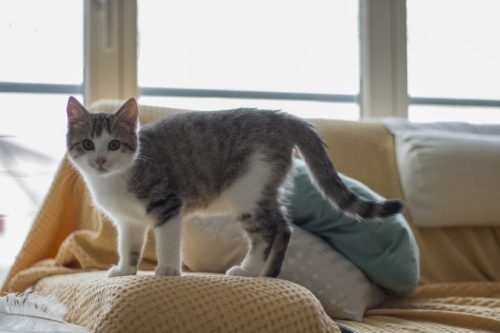Much like humans, skin irritations are commonly seen among our feline friends. Ranging from rashes to abrasions to open wounds, feline skin, like our skin, can be sensitive and can incur many of the same conditions. One type of skin condition, an abscess, while common in cats can be alarming when your pet develops one. Not only are they unsightly, but your cat may experience other complications as a result of the abscess. If you find that your cat has an abscess, it is important to take him to the veterinarian for further evaluation as soon as possible. Early recognition and diagnosis can help avoid further impacts on your cat’s health.
What Is an Abscess in Cats?
Simply put, an abscess can be described as a “pocket of pus” located somewhere in or on the body. Typically, an abscess is further described using its anatomical location. For example, an abdominal abscess occurs within the abdominal cavity while a subcutaneous abscess occurs under the surface of the skin. If an abscess is not located inside a body cavity or deep within tissue, it usually appears suddenly as a painful swelling or lump which may be either firm and warm to the touch, or squishy like a water balloon. Abscesses can be large or small and will frequently cause redness if it is visible under the skin. In some cases, an abscess will rupture, discharging a foul-smelling secretion or may cause local tissue destruction.
Symptoms of Abscess in Cats
Abscesses are usually painful for your cat and, if left untreated, can lead to the development of serious and even life-threatening conditions such as immunodeficiency virus and feline leukemia virus (FeLV). A cat with an abscess will often have a fever, even if the abscess has ruptured and drained to the outside of the body. Should the abscess be located inside the body- in the liver, for instance- fever would be expected, and there may be the additional complication of a disseminated internal infection or bacteria in the bloodstream. Bloodstream infections can occur if the abscess has ruptured internally. It is important to seek immediate veterinary attention as soon as you notice any of the following symptoms:

- Signs of pain, such as pawing at the abscess or limping
- Loss of hair at the site of the abscess
- Bad breath
- Swelling of the face or gums
- Red, swollen, or inflamed skin
- Pus or blood on the skin
- Excessive itching
- Bleeding gums
- Loss of appetite
- Drooling
- Fever
- Lethargy
Not all cats will display noticeable symptoms and by the time you find the abscess, it may have ruptured. This happens when some of the tissue near the injury dies, creating a hole in which pus collects. Pus contains a mixture of dead tissue, white blood cells, and bacteria. The accumulation of pus under the skin creates pressure on the skin, which ruptures and causes the abscess to drain. If it has drained you may notice a thick, yellow and foul smelling discharge and a hole in the abscessed area. If the abscess is deep under the skin, you may notice an indentation when pressure is applied to the area of swelling. Abscesses most often occur around the head, neck, limbs and back and base of the tail.
Types of Abscesses in Cats
There are several causes for the development of an abscess in cats. These include bite wounds, trauma from penetrating injuries, dental issues and some conditions that may predispose a cat to abscess development such as immunosuppression from medications.
Causes of Abscesses in Cats
The most common cause of abscesses in cats is a bacterial infection from a puncture wound, usually a bite from another cat sustained during a cat fight. It is commonly known that even healthy cat mouths contain a lot of bacteria. When a cat bites another cat and punctures the skin, bacteria is introduced into the resulting wound. The wound then becomes infected and depending on the bacteria involved and how deep the bite is, an abscess can result. Certain bacterial species are often seen in abscess formation, and these include:
- Pus-forming bacteria like Staphylococcus, Escherichia coli, certain Streptococcus species, Pseudomonas, Mycoplasma, Pasteurella multocida, Corynebacterium, Actinomyces, Nocardia, and Bartonella
- Bacteria that can only live and grow in the absence of oxygen including Bacteroides, Clostridium, and Fusobacterium
Dental abscesses form when bacteria invades the root of a damaged or fractured tooth.The damage allows bacteria to invade and cause the abscess. Bacteria can also cause tissue damage leading to an abscess if a cat’s tooth breaks or there is an injury that causes the gums to tear.
Penetrating injuries from inanimate objects like sticks, fencing, or other sharp items can also introduce bacteria normally found on a cat’s skin into the wound and lead to skin or internal abscesses. Also, having had a previous infection in the site increases the chances of another abscess if bacteria re-enters the area.
Diagnosing an Abscess in Cats 
Your veterinarian will be able to make a preliminary diagnosis after an initial physical exam based on the presence of symptoms and appearance of skin irritations. This physical exam will usually be sufficient to make a diagnosis, however, your vet may choose to utilize additional testing. Such tests may include a bacterial culture or examining the discharged fluid under a microscope. These methods are particularly useful if the abscess is difficult to diagnose.. Your vet may also choose to take an x-ray in the case of dental abscesses to better understand the severity of the abscess.
In order to help with the diagnosis, be sure to inform your veterinarian of the extent and duration of your cat’s symptoms, as well as your cat’s outdoor activities and any previous history of abscess or infection.
Abscess Treatment
Treatment will typically involve cleansing and lancing the boils on the skin then following with an antibiotic regimen. Depending on its size and scope, lancing the abscess may require your vet to put your cat under general anesthesia in order to put a drain in place. This drain prevents the wound from closing back up, sealing the infection inside. In the case of dental abscesses, your vet will resolve the particular issue through a root canal, extraction, or saving the affected tooth. Dietary changes may also be recommended, but your vet will work with you to determine a plan based on your cat’s specific needs.
Antibiotics are usually prescribed for at least three weeks for both skin and dental abscesses to ensure the infection is completely wiped out. In some cases, your vet may also prescribe pain medication to help ease your cat’s suffering.
For most abscesses, the prognosis is generally good with immediate treatment. However, that will depend on the severity of the abscess and if any complications developed as a result. Follow your veterinarian’s treatment instructions explicitly and you should see complete healing within two weeks and an improvement in just a few days. However, be sure to watch your cat closely so as not to allow him to irritate or disturb the drainage site. Doing so will delay healing and increase vet costs as the drain will need to be replaced. Your vet will likely schedule a follow-up appointment within two to five days of starting treatment to remove the drain. However, do not hesitate to contact your vet if your cat’s condition does not seem to be improving with treatment or if you notice any swelling around the surgical site.
If you do begin to see an improvement in your cat’s behavior and appearance of the abscess it is important to continue administering any antibiotics your veterinarian gave you. Stopping treatment early could result in an aggressive recurrence of the infection.
Abscess Prevention
Once your cat is healed, your vet will likely recommend preventative measures to help avoid a recurrence. For skin abscesses, be sure to monitor or limit your cat’s outdoor activities. This is particularly important if your cat is known to engage in fights with other cats. For dental abscesses, good oral hygiene is key to prevention. This will involve brushing your cat’s teeth frequently, giving them dental treats, eliminating harmful dental habits such as chewing on hard toys or foods.
Given that cats who stay indoors do not run the risk of cat or other animal bites, except in a multi-pet household, it is particularly important to keep a close eye on outdoor cats. If you choose to let your cat be outside on a regular basis, it is crucial to frequently examine him for any new scrapes or wounds. This can help in early detection. A few other tips to help prevent abscesses and infection include: 
- Keep your cat up-to-date on his Rabies vaccination. Abscesses are usually the result of a “bite wound of unknown origin.” In other words, your cat cannot tell you who or what he got in a fight with so you will not know what to avoid in the future. Most states have rigid protocols when it comes to rabies status and quarantines. If your cat is properly vaccinated, a rabies booster may be required after suffering from a mystery bite. If he is not vaccinated, he may be placed under quarantine.
- Keep all other vaccines up-to-date. Besides introducing bacteria into a wound, cat bites, in particular, can transmit serious diseases including viruses that cause feline leukemia (Felv) and FIV (feline AIDS). Ensure your outdoor cat is current on all vaccinations at all times. One lapse in a vaccination schedule could be costly for your feline.
Despite quick and appropriate veterinary treatment, some abscesses can require days of hospitalization or wound care and occasionally even multiple surgeries. If your cat was attacked by a wild animal or feral cat, or is in a debilitated state to begin with, the wounds can be life-threatening. Doing everything you can to prevent or limit the damage of an abscess will go a long way in helping your cat.




